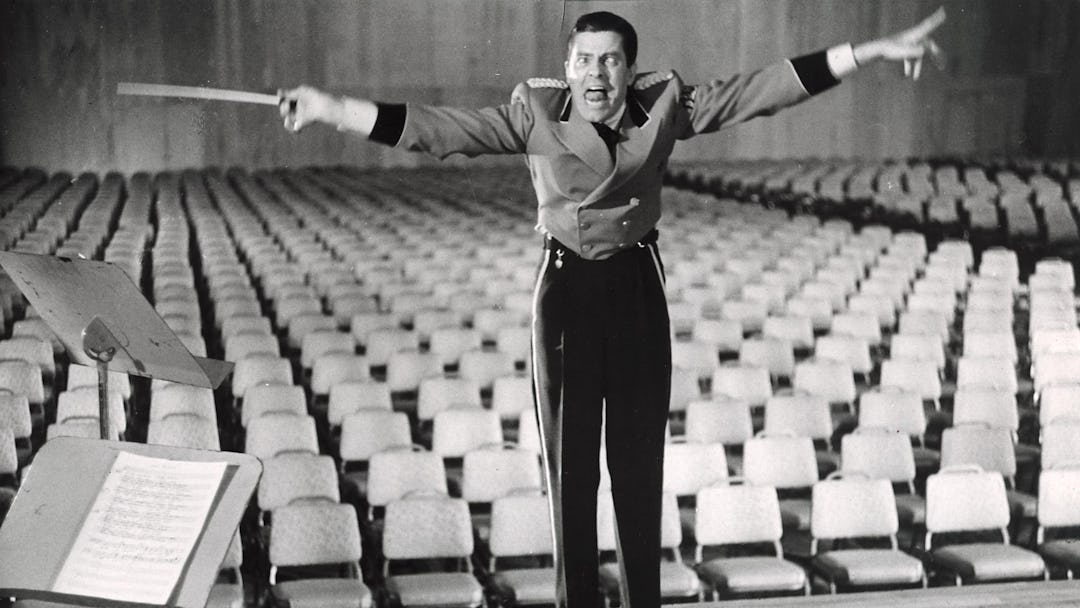There’s nothing comforting about Jerry Lewis. Charlie Chaplin (his greatest influence) had balletic grace, but Jerry was a gawky, screeching, fumbling mess. Jim Carrey (his most obvious successor) has cocky swagger, but Jerry craved to be part of a world that had no use for him. Jacques Tati (another ambitious writer/director) created immaculate cinematic dioramas, but Jerry put his diamond-cut comic set pieces in ungainly, chaotic narratives. Mel Brooks (another 1926-born pillar of comedy) has easily transitioned into a beloved elder statesman, but Jerry has kept his sharp edges. It has been repeated so often that he is under-appreciated in his home country that it smacks of received wisdom, but for a man who once enjoyed a proto-Beatlemania level of fame, there are a lot of barriers to enjoying Jerry Lewis.
Certainly he has defenders in high places. On March 1, the Museum of Modern Art launches a career-spanning retrospective to celebrate his 90th birthday – his second high-profile New York tribute in five months (the Museum of the Moving Image reunited Lewis with his King of Comedy director Martin Scorsese for a Q&A last October). After decades in which Lewis has been more visible as a tiresome, reactionary public figure, the opportunity to revisit his work is a chance to put this difficult artist in context. To appreciate Jerry Lewis, you have to be willing to appreciate pure, unfiltered id.
It is easy to forget in this post-Jim Carrey world that in the late ‘40s and early ‘50s, nobody had ever seen a comedian as wild as Jerry Lewis. His early nightclub act with Dean Martin – “a handsome man and a monkey” – was so funny “you would piss your pants,” according to no less than Orson Welles. The MoMA retrospective dutifully begins with films from the duo’s ten-year partnership: serviceable formula entertainments (and enormous hits in their day) that did little to capture the anarchic power they are said to have had live. The closest things to exceptions are Artist and Models (1955) and Hollywood or Bust (1956), two energetic, cartoon-like satires directed by a bona fide stylist, the former Looney Tunes animator Frank Tashlin.
For the post-Dino years, the retrospective is evenly divided between films directed by Tashlin and by Lewis himself. Tashlin’s are slicker, more coherent, better paced, and consistently funnier – but God help me, I prefer Jerry when he’s the Total Filmmaker. He inherited Tashlin’s candy-colored aesthetic, cartoon comedy, and disregard for the fourth wall, but pushed these tendencies to a lunatic extreme.
As writer/director, he was obsessed by the movie-ness of movies: The Patsy (1964) ends with Jerry’s character realizing that he’s on a movie set, and he’s Jerry Lewis, and the crew should break for lunch; The Ladies Man (1963) unfolds on an enormous dollhouse set that would inspire similar structures in Godard’s Tout va bien and Anderson’s The Life Aquatic. His comedy could be executed with extraordinary precision, as in The Patsy, when he knocks over a roomful of vases, one by one, catching each of them within inches of landing, or Cracking Up (1983), where he performs dozens of pratfalls trying to walk through a slippery office. Like Tati and Buster Keaton, he often seemed more interested in highlighting the beauty of a perfectly choreographed piece of slapstick than getting a belly laugh.
His self-directed work also reveals him as the most nakedly personal of the major film comedians. His films return compulsively to the dilemma of being true to oneself while also fitting into polite society. This dilemma is the melancholy undercurrent of The Patsy, his ambivalent showbiz satire in which he plays a bellboy who becomes a manufactured celebrity. Playing a dual role in The Bellboy, he contrasts his meek, near-silent bellboy character with superstar “Jerry Lewis,” who arrives with a coterie of yes-men and hangers-on (it’s clear who he identifies with more). It’s expressed most clearly in The Nutty Professor, where he plays the nerdy scientist Julius Kelp, who turns himself into the swingin’ hepcat Buddy Love. In what could serve as a thesis statement for Lewis’ career, Kelp concludes, “You might as well like yourself. Just think about all the time you’re going to have to spend with you. And if you don’t think too much of yourself, how do you expect others to?”
And it’s his self-directed work that finds Lewis at his most abrasive. That he was willing to try anything in his films also means that stretches of even his better ones can be brutally unfunny. That he largely abandoned narrative for loosely connected gags means that his films are often not “satisfying,” quote-unquote. That he wrestled with his self-esteem issues on film also means that in Cracking Up, his suicidal misfit spends the entire movie in polished loafers, Brylcreemed hair, and Johnny Carson Apparel-caliber suits. For a Jerryphile, these flaws are part of what makes the work so vital.
I’ll admit that I don’t laugh a lot when watching Jerry, but to quote Andrew Dice Clay from his album The Day the Laughter Died, “This isn’t about laughter. It’s about comedy.” If you’re interested in art that tests the limits of the form, and in artists who lay their guts on a slab for all to see, then you have to be compelled by this man. The secret to appreciating Jerry Lewis isn’t simply taking the bad with the good: it’s enjoying the bad equally.
Happy Birthday, Mr. Lewis: The Kid Turns 90 runs March 1-15 at the Museum of Modern Art.
